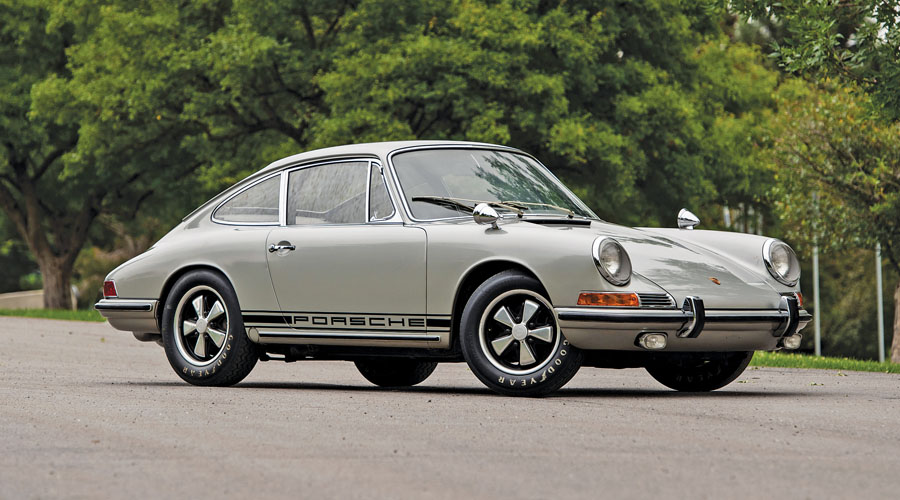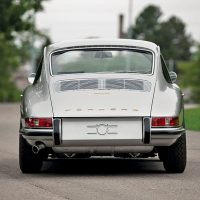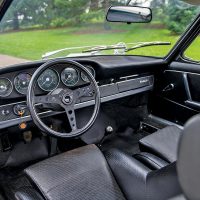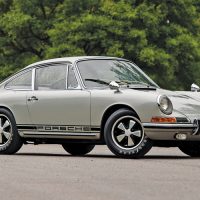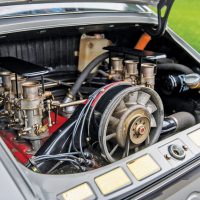SCM Analysis
Detailing
| Vehicle: | 1967 Porsche 911S Sport Kit/Rally Kit |
| Years Produced: | 1967 |
| Number Produced: | 1967 911S coupes 1,823; in this build spec, six to eight cars (estimated) |
| Original List Price: | $6,145 (plus estimated $1,250 in options) |
| SCM Valuation: | $912,500 (this car) |
| Tune Up Cost: | $1,400–$1,500 with wires, cap and valve adjustment |
| Chassis Number Location: | On plate at front lip of trunk panel; chassis stamping above gas tank on passenger’s side |
| Engine Number Location: | On engine case boss under the fan, reading vertically, facing to the right |
| Club Info: | Porsche Club of America |
| Website: | http://www.pca.org |
| Alternatives: | 1967–68 Porsche 911R, 1968 Corvette 427/430 L88, 1966–68 Ferrari 330 GTC, 1967–70 Toyota 2000GT |
| Investment Grade: | A |
This car, Lot 373, sold for $912,500, including buyer’s premium, at RM Sotheby’s auction in Monterey, CA, on August 17, 2019.
The stunning price tells you that this car was not a typical 1967 911S. Even RM Sotheby’s was off — estimating the car at $275,000 to $325,000. Happily for the car’s Denver owner — a restaurant owner with good taste in Porsches — the bidders got it right.
And it was a show.
Competition 911s
Porsche introduced their first prototype into racing in 1954 — the Type 550 Spyder — and continued to improve the breed through 1973, when the 917/30 was their last prototype race car for a few years. Starting with small-displacement-class wins, Porsches moved up to win multiple World Championships with the 908 and different iterations of the 917.
All the while, production-based 356s and 911s were staples in national race series, Cal Club and the SCCA in America and in FIA classes lower than the prototypes.
Porsche 911s were especially effective in rallies such as the Monte Carlo, Tour de France and others. In the United States, 911s scored victories in SCCA production classes, early IMSA and in the Trans-Am series — until the 911 was outlawed for not being a true sedan.
The early 911 “holy grail”
In 1967–68, Porsche built 20 911R lightweight race cars — plus four prototypes. The bodies were built with fiberglass lids, doors, front fenders and bumpers by the Baur firm that also built 904 bodies.
With no undercoating, Plexiglas windows, and no interiors, the cars typically weighed 1,810 pounds vs. 2,380 pounds for a street 911S. Porsche powered the car with an aluminum-case version of the 1,991-cc Type 906 racing engine. In effect, it was Porsche’s version of a muscle car — a “big” engine in a lighter chassis.
Because they built so few, the 911R was not homologated. It raced as a prototype. Still, it achieved notable race/rally victories and speed records. It was also expensive. That becomes relevant to our auction 911S — stay tuned.
Before the 911R, competition 911s were built to order to match sanctioning bodies’ rules. Starting in mid-1966, Porsche organized the chassis and suspension modifications into “kits” — with extra modifications available.
Jack Sullivan ordered a special 911S
Which gets us to our auction car, a 911S with Sport I, Sport Kit II, and a Rally Kit plus many more options. Dr. John “Jack” Sullivan, of Syracuse, NY, ordered the car. A longtime Porsche racer, going back at least to a rare 1952 America Roadster, Sullivan also was known to co-drive with Bruce Jennings.
Interestingly, about the same time, Jennings also ordered a 1967 911S with similar options, but painted brown. Both owners then shod their cars with big Goodyear Blue Streaks and added fender-mounted Talbots. Could they have coordinated the orders? Perhaps. Either way, both men ended up with very special street 911Ss.
In 1969, Sullivan sold his 911S in a two-car deal to Jennings. Bruce had several pure race and street/race cars at this point. He did not use the silver 911S much.
It is thought that Bruce did one race in the car, reported by RM Sotheby’s to have been a 10-lap sprint race at Bridgehampton. Thirty years ago, after I purchased the gold 911R #15 from Miles Collier, Bruce co-drove that car with me in endurance races.
At a Summit Point race, he recounted this story to me: While his race car was getting an engine rebuild, he drove his 911S “driveway car” to nearby Marlboro Raceway, pumped up the tires, raced it, won, let the added air out, and drove it home.
Old school.
Totally original, low miles, with paperwork
As presented at auction, the Sullivan/Jennings 911S had just 8,226 miles. The paint was original, as were the trim and interior.
Included were a toolkit, owner’s manual kit and fulsome paperwork.
The car needed thorough recommissioning and sympathetic detailing. Just before the auction, several would-be bidders wanted to hear the car run better. It was taken to the basement garage of the Portola Hotel. Mechanics drained shellac-like old gasoline, cleaned the carbs, added fresh gas directly to the carbs, and the car ran passably. The car’s 20 years of dead storage in Denver did show through.
Nonetheless, as we chatted in the garage, people opined that they wanted the car, that the auction estimate was light, and that the car undoubtedly would sell over $500,000.
All the performance options — and more
This 911S had extensive paperwork with it, including the build card and three pages explaining the Sport Kits, Rally Kit and other options on the car. The car had the Sport Kit I with bigger venturis and jets for the Weber carburetors, rain lids over the carbs — not air cleaners — and an oil-catch tank. All of this was worth plus-eight horsepower. The Sport Kit II added the straight-pipe, two-outlet sport muffler, worth another seven horsepower — so now plus-15 total, to 175 DIN. The Rally Kit added an interior roll bar, 15-mm and 16-mm anti-sway bars, Ferodo brake pads, a dead pedal and eyehooks for competition seat belts.
Sullivan worked the option list
In addition, Sullivan ordered Scheel sports seats, a limited-slip differential, hillclimb “Bergrennen” gears (one of four competition gear sets available), no undercoating, a smaller-diameter steering wheel, wider wheels and driving lamps.
Our favorite expert on these issues, former Porsche Classic manager Jochen Bader, thinks Bruce Jennings probably added the 100-liter gas tank, beefier 911R-issue Nadella half-shafts and the headrests.
A who’s-who list of Porsche bidders
Then came auction night. To set the scene, there were at least these bidders primed to go after the car:
- A well-known award-winning international architect from NYC.
- A well-known industrialist/collector from the Chicago area with many Porsches and Ferraris, bidding on the phone through an RM Sotheby’s rep.
- A well-known Internet app billionaire with many Porsches.
- A well-known comedian/collector who likes to mix cars and coffee, bidding through his usual representative in the room.
- A well-known scion of a cellular phone business sold to AT&T, bidding through two reps at the side of the room.
- Alois and Estonia Ruf, bidding for a very private international collector.
As auction houses love to say, “There’s money in the room.”
The bidding passed $500,000 in a few minutes. Going up in $25,000 increments, the Chicago industrialist was out at $750,000. The comedian was out at $775,000. Estonia Ruf put in her only bid at $800,000. At $825,000, the winner was the Internet app billionaire sitting right next to me.
THAT was fun.
Can it be called “fairly bought”?
Yes! How? Easy.
The car was rare, with excellent build specs, all-original condition, known provenance, matching numbers, with paperwork.
The only better-spec early SWB 911 would be a 911R, and the last two of those sold recently in Europe for the equivalents of $5,150,000 and $5,500,000. This 911S was 80% off of those prices, and I knew both the 911 Rs — they were nowhere near as original as this 911S.
I think history will say “fairly bought.” ♦
